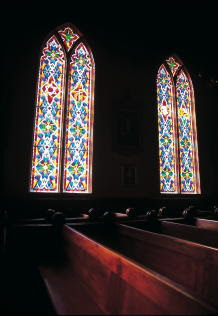
If you read some of the books about old mining towns you might think they all were rough and lawless places that had lots of saloons and gunfights but few churches or schools.
In Virginia City, however, the reality was much different. Nevada historian Ronald James notes the “sinful distractions of the Comstock were certainly no more prevalent than in any other place in the mining West.”
In fact, by the early 1860s Virginia City had grown into a fairly civilized community. In his book, “The Roar and the Silence, A History of Virginia City and the Comstock Lode,” James cites an 1865 report of the State Superintendent of Public Schools that indicates Storey County had no less than a dozen schools, including seven in Virginia City.
Additionally, Virginia City’s citizen’s built marvelous houses of worship. James says that the community’s first congregation was a Methodist group that formed in the late 1850s.
In 1861, the Methodists built Virginia City’s first church, a fine wooden, steepled structure located about a block west of the present-day St. Mary in the Mountains Catholic Church (corner of Taylor and E Streets). The Methodist congregation declined in the early 20th century and the church no longer exists.
Other congregations, however, have had more longevity. The Roman Catholic Church sent its first priest to Virginia City in 1860. While the first Catholic Church building, made of wood, was destroyed by heavy winds, a sturdier structure was soon built, which was named St. Mary in the Mountains.
In the 1870s, the Catholic congregation numbered between 3,000 and 5,000 and was the largest religious group on the Comstock.
There is even a legend surrounding the church that involves the Great Fire of 1875. According to the story, as the fire raced through Virginia City (it eventually destroyed more than 75 percent of the town), many of the Catholic parishioners fought to save the church by pouring water over it.
Mine owner John Mackay, a Catholic, however, was more concerned about the fire reaching his mine and spreading into the underground shafts. He allegedly told Father Patrick Manogue, leader of the church, that if the priest would permit the parishioners to save the mines, he would help rebuild the church.
Whatever the truth, the fire did destroy the church, which was rebuilt between 1875 and 1877. The replacement church—still standing—was an impressive two-story, Gothic Revival brick structure with rosewood balconies and stained glass windows.
Another of Virginia City’s churches is St. Paul’s Episcopal Church, located one block northeast of St. Mary in the Mountains on the corner of F and Taylor Streets. Erected in 1876—an earlier church, erected in 1862, burned in the 1875 fire—St. Paul’s is entirely constructed of native pine.
St. Paul’s has arched ceiling beams and walls that are actually held together with wooden pegs. The original pews and wood-paneled walls are also nearly intact.
Virginia City’s third historic church is the Presbyterian Church on C Street, near the Firehouse. The Presbyterian Church, built in 1867, is the oldest in Virginia City and the only original church not to have burned during the 1875 fire.
The church was financed from money raised by selling mining stocks that had been donated to the congregation. Additionally, the church operated two stores, on either side of the building, which provided money for church activities.
The Presbyterian congregation peaked in the 1860s, with about 750 members. In the 1930s, the building had been converted into the Union Sunday School and then was closed due to its bad condition in 1947.
It has since been restored and is again used for religious services. If you get a chance to tour the church, be sure to check out the old organ; it still bears the burn marks from the great fire of 1875.
All three of Virginia City’s churches are open to the public during selected times (or during Sunday services). For more information, call the Virginia City Chamber of Commerce, 775-847-0311.





